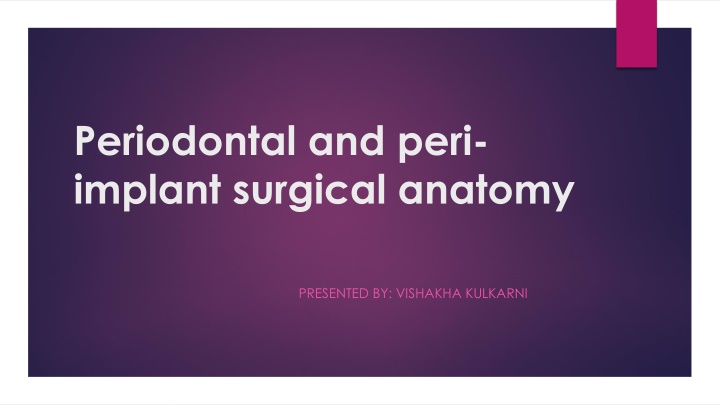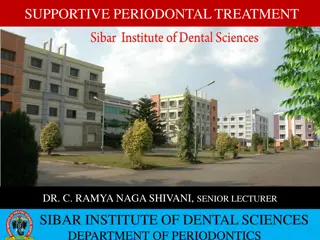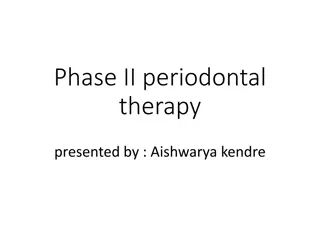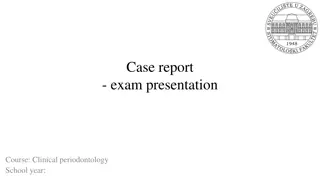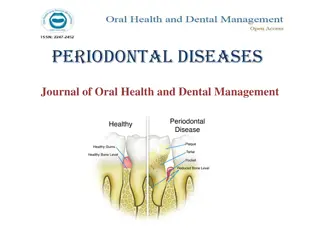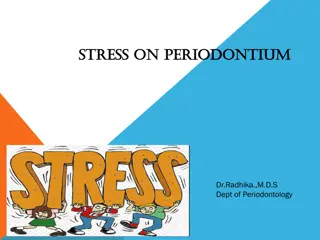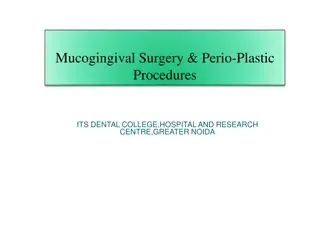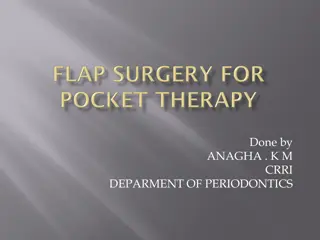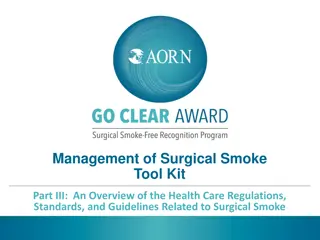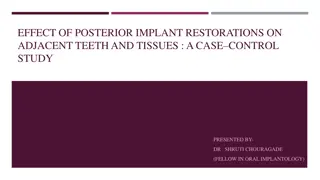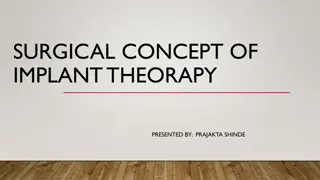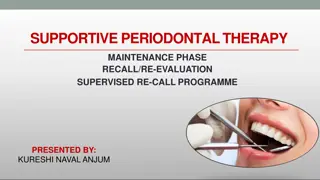Periodontal and Peri-Implant Surgical Anatomy Overview
Sound knowledge of the anatomy of the periodontium and surrounding tissues is essential for successful periodontal and implant surgical procedures. This includes understanding the mandible and maxilla anatomy, muscles, anatomic spaces, and landmarks like the mandibular canal. Proper awareness can help minimize risks during surgical interventions.
Download Presentation

Please find below an Image/Link to download the presentation.
The content on the website is provided AS IS for your information and personal use only. It may not be sold, licensed, or shared on other websites without obtaining consent from the author.If you encounter any issues during the download, it is possible that the publisher has removed the file from their server.
You are allowed to download the files provided on this website for personal or commercial use, subject to the condition that they are used lawfully. All files are the property of their respective owners.
The content on the website is provided AS IS for your information and personal use only. It may not be sold, licensed, or shared on other websites without obtaining consent from the author.
E N D
Presentation Transcript
Periodontal and peri- implant surgical anatomy PRESENTED BY: VISHAKHA KULKARNI
Contents Introduction Anatomy of mandible Anatomy of maxilla Exostoses Muscles Anatomic spaces
Introduction sound knowledge of the anatomy of the periodontium and the surrounding hard and soft tissue structures is essential to determine the scope and possibilities of periodontal and implant surgical pro- cedures and to minimize their risks. The spatial relationship of bones, muscles, blood vessels, and nerves, as well as the anatomic spaces located in the vicinity of the periodontal or implant surgical field, are particularly important.
1.Anatomy of mandible The mandible is a horseshoe-shaped bone connected to the skull by the temporomandibular joints. It presents several landmarks of great surgical importance for both periodontal and implant surgical procedures. The mandibular canal, which is occupied by the inferior alveo- lar nerve and vessels, begins at the mandibular foramen on the surface of the mandibular ramus and curves downward and forward until it becomes horizontal below the apices of the molars. A small percentage (1%) of man- dibular canals bifurcates in the body of the mandible, thereby result- ing in two canals and two mental foramina.
The mental foramen, from which the mental nerve and vessels emerge, is located on the buccal surface of the mandible below the apices of the premolars, sometimes closer to the second premolar and usually halfway between the lower border of the mandible and the alveolar margin (Fig. 43.2). Surgical trauma (e.g.. pressure, manipulation, postsurgical swelling) to the mental nerve can produce paresthesia of the lip which recovers slowly. Partial or complete cutting of the nerve can result in permanent paresthesia, dysesthesia, or both. Familiarity with the location and appearance of the mental nerve reduces the likelihood of injury (Fig. 43.3).
The alveolar process, which provides the supporting bone to the teeth, has a narrower distal curvature than the body of the mandible (Fig. 43.7), thus creating a flat surface in the posterior area between the teeth and the anterior border of the ramus. This results in the formation of the external oblique ridge, which runs downward and forward to the region of the second or first molar (Fig. 43.8) to cre- ate a shelf-like bony area. Resective osseous therapy may be diffi- cult or impossible in this area because of the amount of bone that must be removed distally toward the ramus to achieve resection of a periodontal osseous defect on the distal aspect of the mandibular second or third molar.
Distal to the third molar, the external oblique ridge circums scribes the retromolar triangle (see Fig. 43.8). This region is occ pied by glandular and adipose tissue and covered by unattached nonkeratinized mucosa. If sufficient space exists distal to the lar molar, a band of attached gingiva may be present; only in such case can a distal flap procedure be performed effectively.
Maxilla The maxilla is a paired bone that is hollowed out by the maxillary sinus and the nasal cavity. The maxilla has the following four processes: The alveolar process contains the sockets for and supports themaxillary teeth. The palatine process extends horizontally from the alveolar process to meet its counterpart from the opposite maxilla at the midline intermaxillary suture, and it extends posteriorly with the horizontal plate of the palatine bone to form the hard palate.
The zygomatic process extends laterally from the area above the first molar and determines the depth of the vestibular fornix on the lateral aspect of the maxilla. The frontal process extends in an ascending direction and articu- lates with the frontal bone at the frontomaxillary suture.
The terminal branches of the nasopalatine nerve and vessels pass through the incisive canal, which opens in the midline anterior area of the palate (Fig. 43.10). The mucosa overlying the incisive canal presents a slight protuberance called the incisive papilla. Vessels that emerge through the incisive canal are of small caliber, and their surgical interference is of little consequence. The greater palatine foramen opens 3 to 4 mm anterior to the posterior border of the hard palate (Fig. 43.11).
The mucous membrane that covers the hard palate is firmly attached to the underlying bone. The submucous layer of the pal ate posterior to the first molars contains the palatal glands, which are more compact in the soft palate and extend anteriorly, thereby filling the gap between the mucosal connective tissue and the periosteum and protecting the underlying vessels and nerve
The area distal to the last molar, called the maxillary tuberosity consists of the posterior-inferior angle of the infratemporal surface of the maxilla. Medially it articulates with the pyramidal process of the palatine bone. It is covered by dense, fibrous connective tissue, and it contains the terminal branches of the middle and posterior palatine nerves. Excision of the area for distal flap surgery may reach medially to the tensor palati muscle.
The body of the maxilla is occupied by the maxillary sinus, which is the largest of the paranasal sinuses. It is an air-filled cavity located in the posterior maxilla superior to the teeth. The lateral wall of the nasal cavity borders the sinus medially; it is bordered superiorly by the floor of the orbit and laterally by the lateral wall of the maxilla, the alveolar process, and the zygomatic arch (Fig. 43.13). It is pyramidal, with its apex in the zygomatic arch and its base at the lateral wall of the nasal cavity.
The entire maxillary sinus is lined with a thin mucosal membrane called the schneiderian membrane. The entrance to the maxillary sinus, through the orifice or maxillary duct, is located at the superior medial aspect of the cavity. The orifice is relatively small, measuring only 3 to 6 mm in length and diameter. An accessory opening is occasionally found inferior and posterior to the main opening. The maxillary sinus drains into the middle meatus of the nasal cavity through the maxillary duct, which passes secretions medially to the semilunar hiatus.
Blood supply to the maxillary sinus arises from the superior alveolar (anterior, middle, and posterior) branches of the maxillary artery (Fig. 43.14A). The maxillary artery, which is a large termi nal branch of the external carotid artery, gives off many branches to supply the maxillary sinus, including the infraorbital artery, which travels superiorly and anteriorly and gives off the anterior superior alveolar artery Branches of the greater palatine artery contribute to a lesser extent. Venous blood drains via the pterygoid plexus.
Innerva- tion of the maxillary sinus is supplied by the superior alveolar (anterior, middle, and posterior) nerves and the branches of the maxillary nerve (Fig. 43.14B). the arterial blood supply is particularly impor- tant when considering a lateral window approach to sinus floor elevation and bone augmentation. The inferior wall of the maxillary sinus is frequently separated from the apices and roots of the maxillary posterior teeth by a thin, bony plate In edentulous posterior areas, the maxillary sinus bony wall may be only a thin plate that is in intimate contact with the alveolar mucosa
Adequate determination of the extension of the maxillary sinus into the surgical site is impor- tant to avoid creating an oroantral communication, particularly in relation to osseous reduction in periodontal surgery or surgical pro- cedures for bone augmentation or the placement of implants in edentulous areas. Determining the amount of available bone in the anterior area, below the floor of the nasal cavity, is also critical for the placement of implants.
Exostoses Both the maxilla and the mandible may have exostoses or tori, which are considered to be within the normal range of anatomic variation. Sometimes these structures may hinder the removal of plaque by the patient and may have to be removed to improve the prognosis of neighboring teeth. Additional indications for the removal of exotses include the inability to wear removable prostheses comfortably over these areas. The most common location of a mandibular torusis in the lingual area of the canines and the premolars, above themylohyoid muscle (Fig. 43.18).
Mandibular tori can also be foundon the buccal and labial surfaces of the mandibular teeth. Maxillarytori are usually located in the midline of the hard palate (Fig. 43.19) Smaller tori may be seen over the palatal roots of the maxillary mo-lars, in the area above the greater palatine foramen (see Fig. 43.19),or on the buccal and labial surfaces of the maxillary teeth(Fig. 43.20).
Muscles Several muscles may be encountered when performing periodontal and implant flap surgery, particularly during mucogingival surgery and bone augmentation procedures. These are the mentalis, the in- cisivus labii inferioris, the depressor labii inferioris, the depressor anguli oris (triangularis), the incisivus labii superioris, and the buc- cinator muscles. Their bony attachments are shown in Figure 43.21. These muscles provide mobility to the lips and cheeks.
Anatomic spaces Several anatomic spaces or compartments are found close to the operative field of periodontal and implant surgery sites. These spaces contain loose connective tissue, but they can be easily dis- tended by hemorrhage, inflammatory fluid, and infection. Surgical invasion of these areas may result in dangerous hemor- rhage (intraoperative) or infections (postoperative) and should be carefully avoided. Some of these spaces are briefly described in the following paragraphs. For more information, the reader is referred to other sources.
canine fossa : Contains varying amounts of connective tissue and fat. It is bounded superiorly by the quadratus labii superioris muscle, anteriorly by the orbicularis oris, and posteriorly by the buccinator. Infection of this area results in swelling of the upper lip, which obliterates the nasolabial fold, and of the upper and lower eyelids, which closes the eye. The buccal space: is located between the buccinator and the masseter muscles. Infection of this area results in swelling of the cheek that may extend to the temporal space or the submandibular space, with which the buccal space communicates.
The mental or mentalis space: is located in the region of themental symphysis, where the mental muscle, the depressor muscle of the lower lip, and the depressor muscle of the corner of the mouth are attached. Infection of this area results in large swelling of the chin that extends downward. The masticator space: contains the masseter muscle, the ptery- goid muscles, the tendon of insertion of the temporalis muscle, the mandibular ramus, and the posterior part of the body of the mandi- ble. Infection of this area results in swelling of the face and severe trismus and pain.
The sublingual space: is located below the oral mucosa in the an- terior part of the floor of the mouth. It contains the sublingual gland and its excretory duct, the submandibular or Wharton duct; it is traversed by the lingual nerve and vessels and by the hypoglossal nerves (Fig. 43.22). Its boundaries are the geniohyoid and genioglossus muscles medially, the lingual surface of the mandible below, and the mylohyoid muscle laterally and anteriorly.(fig.43.23)
The submental space: is found between the mylohyoid muscle superiorly and the platysma inferiorly. It is bounded laterally by the mandible and posteriorly by the hyoid bone. It is traversed by the belly of the digastric muscle. Infections of this area arise from the region of the mandibular anterior teeth and result in swelling of the submental region; infections become more dangerous as they proceed posteriorly.
The submandibular space: is found external to the sublingual space, below the mylohyoid and hyoglossus muscles (see Figs. 43.22 and 43.23). This space contains the submandibular gland, which extends partially above the mylohyoid muscle, thereby communicating with the sublingual space and numerous lymph nodes.
